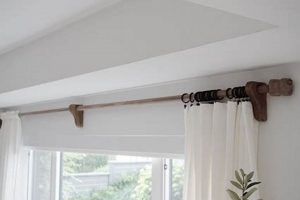Sound-absorbing structures, often constructed from readily available materials, represent a practical solution for mitigating unwanted reverberation and echo in a variety of environments. For example, a frame constructed from wood, filled with mineral wool insulation and covered in fabric, serves as a functional and aesthetically adaptable means of controlling sound reflections within a room.
Employing these sound-dampening elements can lead to significantly enhanced acoustic clarity, beneficial in spaces dedicated to recording, mixing audio, or even improving the intelligibility of speech in conference rooms. Historically, rudimentary forms of sound control, such as tapestries hung on walls, preceded modern approaches to architectural acoustics and laid the groundwork for today’s solutions.
This document will outline the fundamental principles behind acoustic treatment, explore common materials and construction techniques, and provide guidance for implementing customized sound management solutions in diverse settings.
Considerations for Sound Absorption Structures
Effective sound management requires careful consideration of materials, construction methods, and placement. The following provides guidance for maximizing the performance of sound dampening builds.
Tip 1: Frame Construction: Employ sturdy wood for frame construction to provide structural integrity. Ensure frames are square and free of warps to prevent fabric sagging and maintain aesthetic appeal.
Tip 2: Insulation Material Selection: Mineral wool or fiberglass insulation demonstrates superior sound absorption coefficients compared to foam alternatives. Opt for higher density insulation to maximize performance across a broader frequency range.
Tip 3: Fabric Choice and Application: Select acoustically transparent fabric that allows sound waves to penetrate the insulation. Secure the fabric tautly to the frame to create a smooth, professional finish, avoiding wrinkles or bunching that can affect appearance.
Tip 4: Panel Thickness and Placement: Increase panel thickness to improve absorption of lower frequencies. Strategic placement at primary reflection points, such as sidewalls and ceilings, yields the most significant improvements in room acoustics.
Tip 5: Air Gap Optimization: Introducing an air gap behind the structure enhances low-frequency absorption. Experiment with varying air gap depths to fine-tune performance characteristics to suit specific room needs.
Tip 6: Diffusion Integration: While absorption reduces reverberation, diffusion scatters sound waves to prevent flutter echoes and standing waves. Consider incorporating diffusive elements alongside absorptive components for a more balanced acoustic environment.
Tip 7: Safety Considerations: When working with insulation materials, wear appropriate protective gear, including gloves, masks, and eye protection, to prevent skin and respiratory irritation. Ensure proper ventilation during construction.
By adhering to these guidelines, individuals can achieve significant improvements in room acoustics, resulting in a more pleasant and functional sound environment. Sound control is a worthy investment for critical listening and recording spaces.
The subsequent sections delve into the advanced concepts surrounding room acoustics, offering a detailed exploration of diverse treatment strategies.
1. Material Density
Material density represents a crucial parameter in the creation of effective sound absorption structures. Its influence on the acoustic performance of these structures necessitates careful consideration during material selection and construction.
- Low-Frequency Absorption
Denser materials generally exhibit superior low-frequency absorption capabilities. Lower frequencies possess longer wavelengths, requiring materials with greater mass to effectively convert sound energy into heat. In sound absorbing structures, this translates to improved reduction of room modes and overall bass response.
- Resonance and Vibration
Material density affects the resonance characteristics of the entire structure. Less dense materials may be prone to vibration at specific frequencies, potentially leading to unwanted coloration of the sound. A denser structure inherently possesses greater stability and reduced susceptibility to vibration.
- Construction and Stability
Density directly impacts the structural integrity of sound dampening builds. Denser insulation materials typically maintain their shape and form better within the frame, preventing sagging or settling over time. This ensures consistent acoustic performance and prolongs the lifespan of the structure.
- Weight Considerations
While higher density is generally desirable for acoustic performance, it also increases the overall weight of the panel. This necessitates careful consideration of the mounting hardware and wall structure to ensure safe and secure installation. Balancing acoustic benefits with practical weight limitations is paramount.
These considerations highlight the intricate relationship between material density and the performance. While increased density generally translates to improved acoustic properties, it is essential to account for weight, structural integrity, and resonance characteristics to create durable and effective sound-absorbing structures.
2. Frame Construction
The structural framework of sound absorbing builds forms a critical component of their overall acoustic performance and longevity. A well-constructed frame provides support for the absorptive material and fabric covering, influences the panel’s resonant behavior, and ensures secure mounting to the wall or ceiling.
- Material Selection and Rigidity
The selection of framing material directly impacts structural rigidity and resistance to warping. Hardwood or engineered wood products provide superior stability compared to softwood alternatives. A rigid frame minimizes unwanted vibrations and maintains the panel’s shape over time, preventing fabric sagging and ensuring consistent acoustic performance. Example: Using kiln-dried lumber ensures minimal moisture content, reducing the risk of warping after construction.
- Joint Construction and Strength
The method used to join the frame’s components affects its overall strength and resistance to deformation. Mitered corners, reinforced with glue and fasteners, provide a strong and aesthetically pleasing joint. Butt joints, while simpler to construct, are less robust and may require additional reinforcement. Example: Employing pocket hole joinery offers a balance of strength and ease of construction, creating a secure and concealed connection.
- Frame Depth and
Air Gap ConsiderationsThe depth of the frame directly influences the size of the air gap behind the absorptive material. An air gap improves low-frequency absorption by allowing sound waves to diffract around the panel. Optimizing frame depth to achieve a specific air gap is crucial for tuning the panel’s performance to the room’s acoustic characteristics. Example: A deeper frame, creating a larger air gap, is beneficial in spaces with pronounced low-frequency resonance.
- Mounting Hardware Integration
The frame design must accommodate appropriate mounting hardware to ensure secure and stable attachment to the wall or ceiling. Recessed mounting brackets or pre-drilled holes facilitate easy installation and prevent damage to the panel. The frame must be strong enough to support the weight of the panel and resist vibration caused by sound waves. Example: Integrating Z-clips into the frame allows for easy removal and re-installation of the panel for maintenance or adjustments.
These aspects of frame construction showcase its integral role in the overall effectiveness and longevity of sound dampening builds. The frame not only provides structural support but also influences the panel’s acoustic behavior and ease of installation. Careful attention to these considerations leads to superior acoustic performance and a more professional appearance.
3. Fabric Selection
The choice of fabric significantly influences the acoustic performance and aesthetic appeal of sound dampening builds. Proper fabric selection ensures minimal interference with sound wave transmission while complementing the room’s design.
- Acoustic Transparency
Acoustic transparency refers to the fabric’s ability to allow sound waves to pass through with minimal reflection or absorption. Fabrics with a loose weave, such as burlap or muslin, generally exhibit higher acoustic transparency compared to tightly woven materials like canvas or vinyl. Selecting a fabric with appropriate transparency is crucial for maximizing the effectiveness of the underlying absorptive material. Example: Testing fabric by holding it to the mouth and speaking through it provides a rudimentary assessment of its transparency; speech should be clear and unmuted.
- Airflow Resistance
Airflow resistance measures the fabric’s opposition to air passing through it. High airflow resistance impedes sound wave transmission, reducing the panel’s overall absorption coefficient. Fabrics specifically designed for acoustic applications often feature low airflow resistance characteristics. Example: Specialized acoustic fabrics often provide airflow resistance specifications, enabling informed selection based on the desired performance characteristics.
- Aesthetic Considerations
While acoustic performance remains paramount, aesthetic considerations play a significant role in fabric selection. The fabric’s color, texture, and pattern should complement the room’s dcor and create a visually appealing environment. A wide range of fabrics are available in various colors and designs, allowing for customization to suit individual preferences. Example: Neutral-colored fabrics blend seamlessly into most environments, while bolder patterns can serve as visual focal points.
- Durability and Maintenance
Fabric durability and ease of maintenance are important factors to consider, particularly in high-traffic areas. Fabrics that are resistant to stains, fading, and wear and tear will maintain their appearance and performance over time. Washable or easily cleanable fabrics simplify maintenance and prolong the life of the structure. Example: Fabrics treated with stain-resistant coatings offer enhanced protection against spills and stains, simplifying cleaning and preserving the fabric’s appearance.
The selection process must therefore balance acoustic requirements with aesthetic preferences and practical considerations. By carefully evaluating these factors, individuals can select fabrics that enhance both the acoustic performance and visual appeal of their builds, creating a functional and aesthetically pleasing sound-controlled environment.
4. Panel Placement
Strategic placement of sound-absorbing structures directly affects the acoustic properties of a room. Incorrect positioning negates the benefits of the construction effort. Placement addresses primary reflection points, such as side walls, ceilings, and the wall behind speakers, minimizes unwanted sound reflections and reduces reverberation. For instance, a recording studio employing panels solely on the back wall experiences limited improvement compared to a studio treating first reflection points. Optimal placement leads to improved clarity and intelligibility of sound.
The principles of acoustic treatment dictate that early reflections reaching the listener shortly after the direct sound source cause comb filtering and blurred imaging. Panels strategically placed at reflection points absorb these early reflections, preventing them from interfering with the direct sound. Common methods for identifying reflection points include the mirror trick, where an assistant moves a mirror along the wall, and the reflection point is visible when the listener can see the speaker in the mirror. Additionally, acoustic measurement software aids in identifying areas of excessive reverberation or standing waves, guiding placement decisions. A home theater setting that strategically covers key reflective surfaces, versus randomly placing panels, can yield a more immersive experience.
Effective panel placement requires understanding the room’s acoustic characteristics and the intended use of the space. Challenges in achieving optimal placement may include architectural limitations, aesthetic considerations, and budgetary constraints. However, an informed approach to panel placement maximizes the investment in sound absorbing structures. The correct amount and placement makes sound panels a cost effective means of taming sonic reflections within a home or studio.
5. Air Gap Depth
Air gap depth, referring to the space between a sound-absorbing structure and the adjacent wall, exerts a significant influence on the acoustic performance of DIY sound panels. This gap modifies the effective absorption coefficient of the panel, particularly at lower frequencies. An air gap allows sound waves to diffract behind the panel, increasing the path length of the sound wave and promoting greater absorption, particularly when the panel thickness is limited. For instance, a thin panel, such as one constructed from 2-inch thick mineral wool, exhibits considerably improved low-frequency absorption when spaced several inches from the wall. Without an air gap, the same panel primarily absorbs mid and high frequencies, leaving low-frequency modes relatively unaffected. This principle is directly applicable in home studios where bass frequencies can easily overwhelm the small space.
The effectiveness of the air gap is directly proportional to its depth, up to a certain point. The optimal depth varies depending on the panel’s construction and the targeted frequency range. For example, a panel in
tended to absorb frequencies around 100 Hz benefits from a larger air gap than one designed to absorb frequencies above 500 Hz. Numerical modeling and acoustic measurement techniques provide guidance in determining the ideal air gap depth for specific applications. Further, the increase in low frequency response will require further room and placement adjustments.
Constructing DIY sound panels with adjustable mounting hardware allows for experimentation with varying air gap depths to optimize acoustic performance within a given space. Challenges include accounting for room dimensions and existing acoustic properties. Accurate estimation of the required air gap necessitates a comprehensive understanding of room acoustics and the specific performance characteristics of the chosen panel design, ensuring effective sound management tailored to the room’s unique needs.
6. Absorption Coefficient
The absorption coefficient represents a crucial metric in evaluating the effectiveness of sound-absorbing builds. It quantifies the proportion of incident sound energy absorbed by a material or structure, rather than reflected. This value, ranging from 0 to 1, directly indicates the material’s ability to attenuate sound waves. A coefficient of 1 signifies complete absorption, while 0 denotes perfect reflection. For example, a panel with a measured absorption coefficient of 0.8 at 500 Hz absorbs 80% of the sound energy incident upon it at that frequency, while reflecting the remaining 20%.
In the context of sound dampening builds, the absorption coefficient serves as a key performance indicator. Materials with high absorption coefficients, such as mineral wool or fiberglass insulation, are preferentially employed as core components within such structures. The overall effectiveness of a completed panel depends not only on the inherent properties of the absorptive material but also on factors like panel thickness, air gap depth, and the acoustic transparency of the fabric covering. Furthermore, it is imperative to consider the frequency-dependent nature of the absorption coefficient. A material might exhibit high absorption at mid frequencies but perform poorly at low frequencies, necessitating careful selection and design to address the specific acoustic challenges within a given space. For instance, thicker panels and strategically placed air gaps enhance low-frequency absorption.
Understanding the absorption coefficient is essential for informed decision-making in sound control efforts. By consulting published absorption coefficient data for various materials and considering the design parameters discussed, individuals can create sound dampening builds tailored to their specific acoustic needs. While theoretical calculations provide a valuable starting point, real-world performance can vary depending on construction techniques and environmental factors. Therefore, acoustic measurement tools, or software applications, provide empirical validation of panel performance. Properly designed structures, informed by a comprehension of the absorption coefficient, contribute to improved sound clarity, reduced reverberation, and a more controlled acoustic environment.
7. Mounting Strategy
The method of attachment of sound panels to a surface directly impacts both their acoustic effectiveness and their physical integrity. Improper installation can reduce the panel’s ability to absorb sound and could potentially lead to structural failure or damage to the mounting surface. Selection of a mounting strategy requires consideration of panel weight, wall composition, and desired permanence.
Different mounting strategies offer varying degrees of permanence and adjustability. For example, adhesive-based mounting provides a non-invasive option suitable for temporary installations or lightweight panels. However, adhesive strength limits its applicability to heavier panels, and removal can damage the wall surface. Conversely, screw-based mounting offers greater load-bearing capacity and long-term stability. Proper anchoring is crucial when using screws, especially on drywall or plaster, to prevent the panel from detaching. Z-clips, another mounting option, enable easy removal and re-positioning of panels, making them suitable for flexible acoustic arrangements. A studio owner choosing to install heavy, custom-built sound absorbing structures would likely opt for a robust screw-based system with appropriate wall anchors, while a renter seeking temporary sound treatment for a home office might choose an adhesive solution or Z-clips.
Effective panel installation begins with precise measurement and marking of mounting locations. Misalignment affects visual aesthetics and the intended acoustic benefits. The chosen mounting hardware must be compatible with both the panel’s construction and the wall material. By carefully selecting and implementing the appropriate mounting strategy, individuals constructing DIY sound panels can ensure both optimal acoustic performance and long-term stability of their creations. The mounting strategy is a vital, integral aspect for any DIY sound panel project.
Frequently Asked Questions Regarding DIY Acoustic Panels
This section addresses common inquiries concerning the construction and application of these sound-absorbing structures, providing clarity on prevalent issues and misconceptions.
Question 1: What materials are suitable for constructing the frame?
Solid wood, such as pine or poplar, and engineered wood products, like MDF, provides adequate structural support. The material selected should be straight, free of knots, and exhibit minimal warping.
Question 2: What type of insulation material provides the most effective sound absorption?
Mineral wool and fiberglass insulation possess superior sound absorption characteristics compared to alternatives like foam. Higher density insulation materials generally perform better across a broader frequency spectrum.
Question 3: How does fabric selection impact acoustic performance?
Acoustically transparent fabrics, characterized by a loose weave, allow sound waves to penetrate the insulation material with minimal reflection. Tightly woven fabrics impede sound transmission, reducing the overall effectiveness of the panel.
Question 4: Where should acoustic panels be placed for optimal sound control?
Strategic placement targets primary reflection points on side walls, ceilings, and the wall behind speakers. Identifying these points, often achieved using the mirror trick, maximizes the impact of the panels on room acoustics.
Question 5: Does an air gap behind the panel improve acoustic performance?
Introducing an air gap enhances low-frequency absorption by allowing sound waves to diffract around the panel. The depth of the air gap influences the frequency range affected, requiring careful consideration of room acoustics.
Question 6: How does one determine the appropriate number of panels needed for a room?
The quantity of panels depends on the room’s dimensions, surface materials, and intended use. Acoustic measurement tools or simulations provide guidance in determining the optimal number of panels for achieving the desired acoustic environment.
DIY acoustic panels offer a cost-effective and customizable solution for improvin
g room acoustics. An informed approach to design, material selection, and placement is crucial for achieving significant results.
The next section will explore more advanced applications of sound panels.
Conclusion
This exposition of “diy acoustic panels” has illuminated their fundamental construction principles, material considerations, and strategic deployment. A thorough understanding of these elements empowers individuals to create tailored acoustic solutions, addressing specific sound management challenges within diverse environments. Key takeaways include the importance of material density, proper frame construction, acoustically transparent fabric selection, strategic panel placement, optimization of air gap depth, and comprehension of the absorption coefficient.
The careful application of these concepts facilitates measurable improvements in acoustic clarity, sound isolation, and overall environmental sound quality. Continued research and experimentation in acoustic treatment methodologies promise further advancements in effective and accessible sound management solutions, reinforcing the enduring relevance of these cost-effective approaches to room acoustics control.







